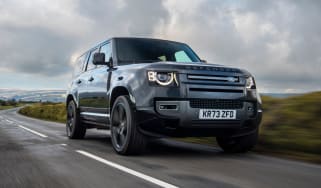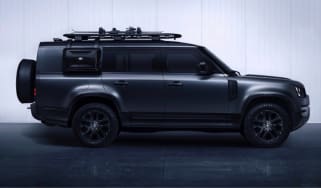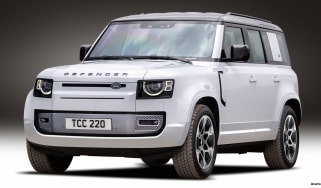Land Rover Defender review: ace off-roader and versatile family car
The Land Rover Defender is one of the most complete cars on sale, combining a rugged go-anywhere ability with newfound civility

Many will be sold on the Land Rover Defender by just its looks alone, but that would be to sell short what a wonderful representation of modern British engineering it is. The latest Defender has silenced the doubters and proven itself worthy of the famous name, because it still has an almost unmatched level of off-road ability at its core, yet it has all the refinements expected by SUV buyers.
That it has the breadth of abilities to be a practical family wagon, a farmer-friendly workhorse, or a glitzy city-dwelling luxury car is incredible. You’ll have to pay handsomely for this privilege, though, and there are all kinds of other rivals to consider – some of which are far more fuel-efficient. However, few of those rivals possess the character and desirability of the Land Rover Defender.
About the Land Rover Defender
It took Land Rover a long time to replace the iconic Defender 4x4, but when it did, there was no messing about. There was some initial consternation about some of the fundamental changes, things like the move to a unibody chassis design and a complete reliance on electronics to control its sophisticated four-wheel drive system, but there’s no doubt the latest model can wear its Defender badges with pride. We think it's an icon reborn, and awarded it the title of Large Premium SUV of the Year at our 2022 New Car Awards.
More reviews
Car group tests
- Land Rover Defender vs Ineos Grenadier vs Ford Ranger Raptor: the ultimate off-road shootout
- The best long-term car tests 2022
Long-term tests
Road tests
- Land Rover Defender 130 Outbound 2024 review: goodbye extra seats, hello enormous boot
- Land Rover Defender 130 P500 2024 review: plenty of space and power, but also rather excessive
- Land Rover Defender 90 D300 75th Limited Edition 2023 review
- Land Rover Defender 130 D300 2022 review
Used car tests
Underneath the equally retro and sleek exterior design, the latest Land Rover Defender is worlds apart from its more agricultural ancestor, which is for the better. The old car’s clunky solid axles have been replaced with a new independent system. This can be paired with either coil springs or adjustable air suspension, the latter helping it ride more comfortably without giving up anything in terms of off-road ability. Driving a Defender long distances on the motorway is no longer a hardship; it’s now a brilliant long-legged cruiser.
But it wasn’t only consumers demanding change, because as emissions and safety regulations continue to tighten, it was no longer possible to keep the old Defender in production. That said, no modern Defender could reasonably be called frugal, but depending on your usage, the vast spread of diesel, petrol and plug-in hybrid options means there’s almost certainly a powertrain option to suit your needs.
The interior is a real highlight. It feels very well built and plush enough for everyday use without being so fancy and delicate that you worry about using the car off-road like its maker intended. That being said, you can replace some of the hard-wearing technical fabrics with Range Rover-like leathers and polished wood, if you want. Versatility is ace, with five, six, seven or even eight-seat options available. Interior tech is also very good, especially with the larger Pivi Pro infotainment system.
This wide range of abilities means that the competition for the Defender is huge. The Ineos Grenadier, Jeep Wrangler and Mercedes G-Class are similarly good off-road, but all retain a body-on-frame chassis design, and come with the relevant disadvantages this construction is known for when it comes to driving on-road. The Grenadier and Wrangler both feel archaic to drive, and cannot match the Land Rover’s day-to-day comfort. The G-Class is also compromised on-road due to its construction, but it is a lot more refined than the other two mentioned here, plus few will care because the G-Class has an incredibly desirable image. It is far more expensive, though.
A SsangYong Rexton could be a cheaper alternative if you don’t mind living with something that feels a lot more agricultural. Most will likely consider more luxurious alternatives such as the BMW X5, Mercedes-Benz GLE, Lexus RX, or Volvo XC90 when debating whether to buy a Defender. Then there’s the Toyota Land Cruiser, which sports similarly bold retro styling as the Defender.
If more rugged farm work is what you’re after, there are various double-cab pick-up trucks to look at, such as the Ford Ranger, Volkswagen Amarok and Toyota Hilux. All three deliver serious 4x4 ability, although, again, none match the refinement of the Defender on-road. There’s also the Land Rover Discovery elephant in the room, which the brand is all too aware is often cross-shopped with the Defender because the latter is that little bit more desirable.
Defender customers have a choice of three-door Defender 90, five-door Defender 110, and stretched-out 130 models. The range starts from just under £57,500 for an entry-level Hard Top 90 with the D250 diesel, rising to just over £58,000 for the 90 with the D350. The P300 SE 90 and larger 110 start at around £60,000, while the three-row 130 starts at over £81,000.
Two diesel engines are on offer for the entire Defender family: the D250 and D350. Both versions use a 3.0-litre, six-cylinder in-line unit with mild-hybrid tech. The D250 produces 247bhp, while the D350 (which replaces the 296bhp D300) produces a much more potent 345bhp.
The petrol options include a P425, which replaces the old P400 straight-six for emissions regulations with a 5.0-litre supercharged V8 producing 425bhp. A slightly greener alternative comes in the form of the plug-in hybrid P300e, which uses a 300bhp 2.0-litre four-cylinder engine plus an electric motor. The P300e delivers the best on-paper economy and lower CO2 emissions, but it can be extremely thirsty once out of electricity.
There’s also a supercharged V8 petrol option featuring JLR’s 5.0-litre engine with 518bhp in high-spec 90 and 110 models, plus a 496bhp version of the same V8 engine on the top-spec 130. All Defenders use the same eight-speed auto transmission, plus four-wheel drive and a version of Land Rover’s Terrain Response system with a number of preset driving modes to help you get through different types of off-road driving terrain. There is a more advanced off-road package available with additional off-road driving goodies, such as an electronic locking differential to maximise traction in slippery conditions, plus variable height air suspension so you can clear obstacles more easily.
Trim levels vary depending on which engine and body you choose, and you may need to be flexible because your preferred engine may not be available with the trim or body style you want. The range starts at just over £57,500 for a Hard Top S, rising to almost £68,000 for the X-Dynamic HSE. The X-Dynamic specification adds privacy glass, a black roof, and satin dark grey 20-inch alloy wheels and matching satin dark grey exterior trim highlights to their respective SE and HSE specifications. The X-Dynamic HSE is also the only Hard Top to be offered with the D350, while all others get the D250.
The 90 starts at just over £58,000 and can be had with both diesels or, in Defender X specification, the P425 petrol. It can also be equipped with the range-topping V8 in the creatively named ‘V8’ guise. The V8 model is the current flagship, coming in at nearly £110,000, and is signified by the quad exhaust outlets and blue highlights around the brake calipers – oh, and the massive supercharged V8 engine.
The 130, meanwhile, has since received the rugged Outbound edition, which removes the rear-most windows and the third row of seating, unlocking a massive cargo space. It costs just over £83,000 in D300 form and seems to offer some of the versatility of the commercial Hard Top editions of the Defender while maintaining seating for four in case you need to take the family somewhere for the weekend.
Several special edition Defenders have come and gone for the current model. Right now there’s the Sedona Edition with exclusive ‘Sedona Red’ paint, ‘Extended Black Pack’ with black ‘Defender’ badging, plus black finishes for the front grille, skid plates and 22-inch wheels. The Sedona Edition is priced at around £83,000 and comes with the D350 or the plug-in hybrid.
Land Rover Defender P400e long-term test
Back in 2023, Editor-in-Chief Steve Fowler ran a plug-in hybrid Land Rover Defender 110 P400e for a long-term test. He loved a number of thoughtful interior design touches that just made life that little bit easier, including the ability to have updates carried out over the air, meaning he didn’t have to endure time-consuming trips to the Land Rover dealer.
He even lent the Defender to his friend Adrian Chiles, who took it on an extended European holiday. However, such a trip with no charging, plus Steve’s regular trips to Liverpool and back to watch the football, meant fuel consumption overall was around 30mpg, so he reckoned he’d have been better off choosing the cheaper to buy diesel instead.
Frequently Asked Questions
Setting fuel economy aside, there are few other cars that are as easy to get on with, as capable, and as versatile as the current Land Rover Defender. If you can afford one, you won’t be disappointed




























